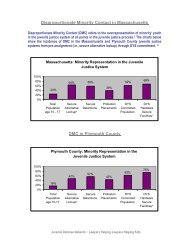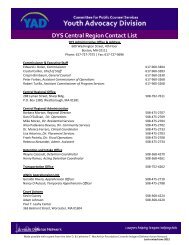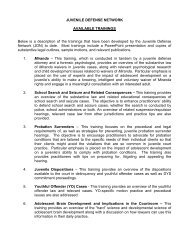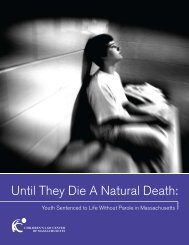Adolescent Brain Development - the Youth Advocacy Division
Adolescent Brain Development - the Youth Advocacy Division
Adolescent Brain Development - the Youth Advocacy Division
You also want an ePaper? Increase the reach of your titles
YUMPU automatically turns print PDFs into web optimized ePapers that Google loves.
activated <strong>the</strong> amygdala, a brain center that mediates fear and o<strong>the</strong>r "gut" reactions, more than <strong>the</strong><br />
frontal lobe. As teens grow older, <strong>the</strong>ir brain activity during this task tends to shift to <strong>the</strong> frontal<br />
lobe, leading to more reasoned perceptions and improved performance. Similarly, <strong>the</strong> researchers<br />
saw a shift in activation from <strong>the</strong> temporal lobe to <strong>the</strong> frontal lobe during a language skills task,<br />
as teens got older.” (2)<br />
V. Expert Testimony/Briefs<br />
Petitioner Brief, Graham v. Florida (2010)<br />
Successful Supreme Court brief arguing against juvenile life without parole for non-homicide offenses<br />
committed by juveniles under 18. Cites Roper and adolescent brain research extensively.<br />
Petitioner Brief, Sullivan v. Florida (2009)<br />
Brief arguing against juvenile life without parole for non-homicide offense committed by 13-year-old.<br />
Cites Roper and adolescent brain research extensively.<br />
Amici Curiae Brief of <strong>the</strong> American Psychological Association, et al., Sullivan and Graham (2009)<br />
http://www.abanet.org/publiced/preview/briefs/pdfs/07-08/08-7412_PetitionerAmCu4HealthOrgs.pdf<br />
The APA and o<strong>the</strong>rs’ amicus brief in Sullivan and Graham that cites heavily to new brain science<br />
Testimony of David Fassler, M.D., New Hampshire State Legislature (2004)<br />
http://ccjr.policy.net/relatives/22020.pdf (.pdf format)<br />
Testimony given to <strong>the</strong> State Legislature of New Hampshire in efforts to outlaw <strong>the</strong> juvenile death penalty<br />
in <strong>the</strong> state (relies heavily on brain development arguments)<br />
Declaration of Ruben C. Gur, Ph.D., Patterson v. Texas (2002)<br />
http://www.abanet.org/crimjust/juvjus/Gur%20affidavit.pdf (.pdf format)<br />
Declaration in Patterson v. Texas (juvenile death penalty case) citing heavily upon recent science<br />
regarding adolescent brain development<br />
VI. Supreme Court Opinions<br />
Graham v. Florida – 560 U.S. ____ (2010)<br />
Supreme Court case that declared life without parole unconstitutional for juvenile offenders under 18<br />
convicted of nonhomicide crimes.<br />
Quotes from Graham v. Florida<br />
Potentially useful language from <strong>the</strong> Graham decision.<br />
Roper v. Simmons – 543 U.S. 551 (2005)<br />
Supreme Court case that declared <strong>the</strong> juvenile death penalty unconstitutional and discusses <strong>the</strong><br />
developmental differences between juveniles under age 18 and adults.<br />
Atkins v. Virginia – 536 U.S. 304 (2002)<br />
Supreme Court case that declared <strong>the</strong> death penalty for mentally retarded persons unconstitutional (uses<br />
arguments of brain development)<br />
Thompson v. Oklahoma – 487 U.S. 815 (1988)<br />
Supreme Court case that declared <strong>the</strong> death penalty illegal for youth under <strong>the</strong> age of 16.

















